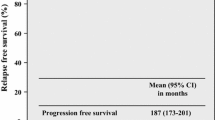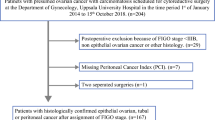Abstract
Purpose
The aim of this study was to investigate whether preoperative laparoscopic evaluation of the dissemination of disease may have an independent impact on survival in advanced epithelial ovarian cancer (AEOC).
Methods
All AEOC women were submitted to staging laparoscopy before receiving primary debulking surgery (PDS) or neoadjuvant chemotherapy (NACT). All study women received a laparoscopic score (predictive index value [PIV]) and were stratified into three groups based on volume of disease: high tumor load (HTL) for PIV ≥8, intermediate tumor load (ITL) for PIV equal to 6 and 4, and low tumor load (LTL) for PIV <4. Surgical and survival outcome were evaluated by univariate and multivariate analysis.
Results
Among 348 consecutive patients, almost half (48.0 %) had an HTL. Among 165 cases receiving PDS, residual tumor (RT) was as follows: no gross residual in 102 patients (61.8 %); RT ≤1 cm in 48 patients (29.1 %) and RT >1 cm in 15 cases (9.1 %). When stratifying the whole population according to laparoscopic tumor load, the median progression-free survival (PFS) was 33 months for LTL, 18 months for ITL, and 14 months for HTL (p = 0.0001). The median overall survival (OS) with respect to laparoscopic PIV was not reached for LTL, whereas it was 47 months for ITL and 33 months for HTL, respectively (p = 0.0001). At multivariate analysis, tumor load stratified by PIV retained an independent prognostic value on PFS and OS, together with RT and performance status.
Conclusions
RT remains an important prognostic factor in patients with AEOC, but tumor dissemination can play a role in determining prognosis in these women.


Similar content being viewed by others
References
Chi DS, Eisenhauer EL, Lang J, Huh J, Haddad L, Abu-Rustum NR, et al. What is the optimal goal of primary cytoreductive surgery for bulky stage IIIC epithelial ovarian carcinoma (EOC)? Gynecol Oncol. 2006;103:559–64.
Bristow RE, Tomacruz RS, Armstrong DK, Trimble EL, Montz FJ. Survival effect of maximal cytoreductive surgery for advanced ovarian carcinoma during the platinum era: a meta-analysis. J Clin Oncol. 2002;20:1248–59.
Winter WE III, Maxwell GL, Tian C, Carlson JW, Ozols RF, Rose PG, et al.; Gynecologic Oncology Group. Prognostic factors for stage III epithelial ovarian cancer: a Gynecologic Oncology Group Study. J Clin Oncol. 2007;25:3621–7.
Chi DS, Franklin CC, Levine DA, Akselrod F, Sabbatini P, Jarnagin WR, et al. Improved optimal cytoreduction rates for stages IIIC and IV epithelial ovarian, fallopian tube, and primary peritoneal cancer: a change in surgical approach. Gynecol Oncol. 2004;94:650–4.
Fanfani F, Fagotti A, Gallotta V, Ercoli A, Pacelli F, Costantini B, et al. Upper abdominal surgery in advanced and recurrent ovarian cancer: role of diaphragmatic surgery. Gynecol Oncol. 2010;116(3):497–501.
Gallotta V, Fanfani F, Vizzielli G, Panico G, Rossitto C, Gagliardi ML, et al. Douglas peritonectomy compared to recto-sigmoid resection in optimally cytoreduced advanced ovarian cancer patients: analysis of morbidity and oncological outcome. Eur J Surg Oncol. 2011;37(12):1085–92.
Tanner EJ, Long KC, Feffer JB, Leitao MM Jr., Abu-Rustum NR, Barakat RR, et al. Parenchymal splenic metastasis is an independent negative predictor of overall survival in advanced ovarian, fallopian tube, and primary peritoneal cancer. Gynecol Oncol. 2013;128(1):28–33.
Hamilton CA, Miller A, Miller C, Krivak TC, Farley JH, Chernofsky MR, et al. The impact of disease distribution on survival in patients with stage III epithelial ovarian cancer cytoreduced to microscopic residual: a Gynecologic Oncology Group study. Gynecol Oncol. 2011 Sep;122(3):521–6.
Van Meurs HS, Tajik P, Hof MH, Vergote I, Kenter GG, Mol BW, et al. Which patients benefit most from primary surgery or neoadjuvant chemotherapy in stage IIIC or IV ovarian cancer? An exploratory analysis of the European Organisation for Research and Treatment of Cancer 55971 randomised trial. Eur J Cancer. 2013;49(15):3191–201.
Rodriguez N, Miller A, Richard SD, Rungruang B, Hamilton CA, Bookman MA, et al. Upper abdominal procedures in advanced stage ovarian or primary peritoneal carcinoma patients with minimal or no gross residual disease: an analysis of Gynecologic Oncology Group (GOG) 182. Gynecol Oncol. 2013;130(3):487–92.
Fagotti A, Fanfani F, Ludovisi M, Lo Voi R, Bifulco G, Testa AC, et al. Role of laparoscopy to assess the chance of optimal cytoreductive surgery in advanced ovarian cancer: a pilot study. Gynecol Oncol. 2005;96(3):729–35.
Fagotti A, Ferrandina G, Fanfani F, Garganese G, Vizzielli G, Carone V, et al. Prospective validation of a laparoscopic predictive model for optimal cytoreduction in advanced ovarian carcinoma. Am J Obstet Gynecol. 2008;199(6):642.e1-6.
Fagotti A, Vizzielli G, Costantini B, Lecca A, Gallotta V, Gagliardi ML et al. Learning curve and pitfalls of a laparoscopic score to describe peritoneal carcinosis in advanced ovarian cancer. Acta Obstet Gynecol Scand. 2011;90(10):1126–31.
Fagotti A, Fanfani F, Vizzielli G, Gallotta V, Ercoli A, Paglia A, et al. Should laparoscopy be included in the work-up of advanced ovarian cancer patients attempting interval debulking surgery? Gynecol Oncol. 2010;116(1):72–7.
Fagotti A, Vizzielli G, De Iaco P, Surico D, Buda A, Mandato VD, et al. A multicentric trial (Olympia-MITO 13) on the accuracy of laparoscopy to assess peritoneal spread in ovarian cancer. Am J Obstet Gynecol. 2013;209(5):462.e1–11.
Fagotti A, Vizzielli G, Fanfani F, Costantini B, Ferrandina G, Gallotta V, et al. Introduction of staging laparoscopy in the management of advanced epithelial ovarian, tubal and peritoneal cancer: impact on prognosis in a single institution experience. Gynecol Oncol. 2013;131(2):341–6.
Ferrandina G, Sallustio G, Fagotti A, Vizzielli G, Paglia A, Cucci E, et al. Role of CT scan-based and clinical evaluation in the preoperative prediction of optimal cytoreduction in advanced ovarian cancer: a prospective trial. Br J Cancer. 2009;101(7):1066–73.
Aletti GD, Eisenhauer EL, Santillan A, Axtell A, Aletti G, Holschneider C, et al. Identification of patient groups at highest risk from traditional approach to ovarian cancer treatment. Gynecol Oncol. 2011;120(1):23–8.
Kurman RJ, Shih IeM. The origin and pathogenesis of epithelial ovarian cancer: a proposed unifying theory. Am J Surg Pathol. 2010;34(3):433–43.
Therasse P, Arbuck SG, Eisenhauer EA, Wanders J, Kaplan RS, Rubinstein L, et al. New guidelines to evaluate the response to treatment in solid tumors. European Organization for Research and Treatment of Cancer, National Cancer Institute of the United States, National Cancer Institute of Canada. J Natl Cancer Inst. 2000;92:205–16.
Rustin GJ, Marples M, Nelstrop AE, Mahmoudi M, Meyer T. Use of CA-125 to define progression of ovarian cancer in patients with persistently elevated levels. J Clin Oncol. 2001;19:4054–7.
Pignata S, Scambia G, Katsaros D, Gallo C, Pujade-Lauraine E, De Placido S, et al. Multicentre Italian Trials in Ovarian cancer (MITO-7); Groupe d’Investigateurs Nationaux pour l’Etude des Cancers Ovariens et du sein (GINECO); Mario Negri Gynecologic Oncology (MaNGO); European Network of Gynaecological Oncological Trial Groups (ENGOT-OV-10); Gynecologic Cancer InterGroup (GCIG) Investigators. Carboplatin plus paclitaxel once a week versus every 3 weeks in patients with advanced ovarian cancer (MITO-7): a randomised, multicentre, open-label, phase 3 trial. Lancet Oncol. 2014;15(4):396–405.
Kaplan EL, Meier P. Nonparametric estimation from incomplete observations. J Am Stat Assoc. 1958;53:457–81.
Mantel N. Evaluation of survival data and two new rank order statistics arising inits consideration. Cancer Chemother Rep. 1996;50:163–70.
Harmon RL, Sugarbaker PH. Prognostic indicators in peritoneal carcinomatosis from gastrointestinal cancer. Int Semin Surg Oncol. 2005;8:2–3.
Eisenkop SM, Spirtos NM, Friedman RL, Lin WC, Pisani AL, Perticucci S. Relative influences of tumor volume before surgery and the cytoreductive outcome on survival for patients with advanced ovarian cancer: a prospective study. Gynecol Oncol. 2003;90:390–6.
Aletti GD, Santillan A, Eisenhauer EL, Hu J, Aletti G, Podratz KC, et al. A new frontier for quality of care in gynecologic oncology surgery: multi-institutional assessment of short-term outcomes for ovarian cancer using a risk-adjusted model. Gynecol Oncol. 2007;107:99–106.
Disclosure
Giuseppe Vizzielli, B. Costantini, L. Tortorella, M. Petrillo, F. Fanfani, V. Chiantera, A. Ercoli, R. Iodice, G. Scambia, and A. Fagotti declare no conflicts of interest.
Author information
Authors and Affiliations
Corresponding author
Rights and permissions
About this article
Cite this article
Vizzielli, G., Costantini, B., Tortorella, L. et al. Influence of Intraperitoneal Dissemination Assessed by Laparoscopy on Prognosis of Advanced Ovarian Cancer: An Exploratory Analysis of a Single-Institution Experience. Ann Surg Oncol 21, 3970–3977 (2014). https://doi.org/10.1245/s10434-014-3783-6
Received:
Published:
Issue Date:
DOI: https://doi.org/10.1245/s10434-014-3783-6




